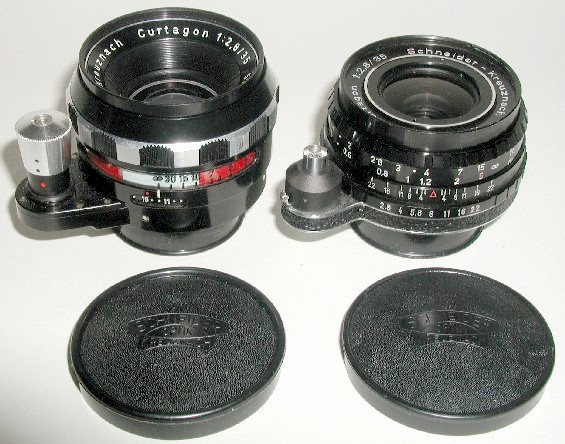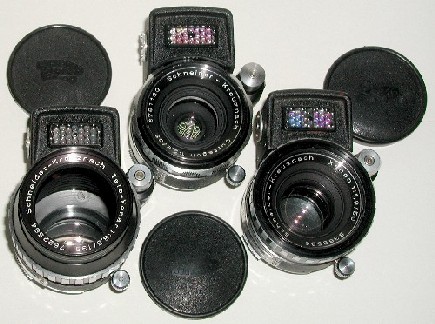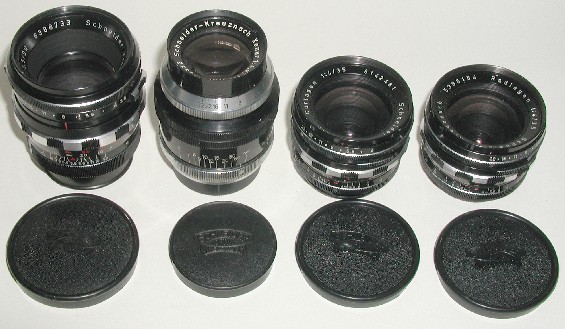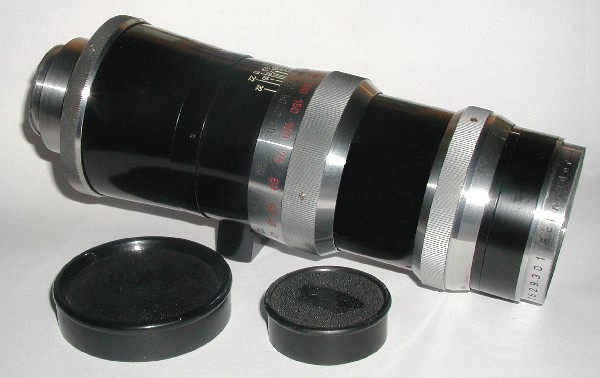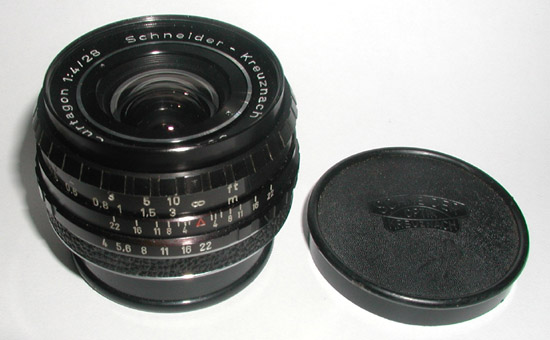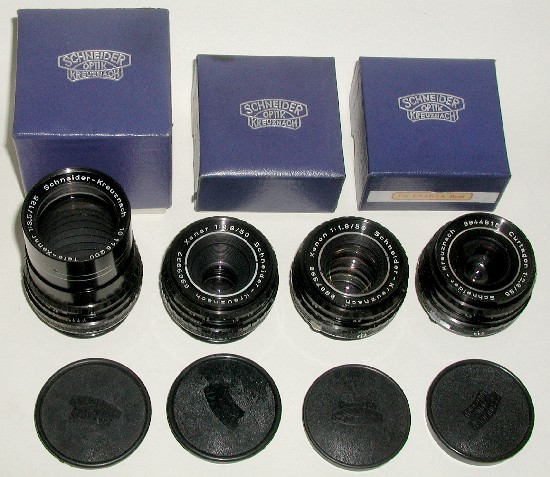 |
Schneider Exakta Lenses |
|
The Kreuznach, Germany optical firm of Joseph Schneider & Co. has always been closely associated with the Exakta. Even before the inception of the Kine-Exakta right up to the present day medium format cameras bearing the Exakta name, Schneider optics have been widely available, sought after and used on virtually every model. In addition to the Exakta mount, Schneider lenses can be found in many other camera mounts, with Praktica/Edixa/Pentax (M-42) screw mount and Alpa, the most common. In 35mm Exakta mount, Schneider has produced fine lenses in focal lengths from 28mm to 360mm and a few noteworthy zoom lenses as well. Their automatic diaphragm lenses in which I specialize, were produced in the 28mm to 135mm range, with several versions of each. In addition to the automatic lenses, I also have a perspective control lens (PA-Curtagon) as well as a number of interesting preset lenses whose focal lengths, complement the focal lengths available in the Schneider automatic diaphragm versions. The Schneider Automatics The Schneider automatic lenses in my collection include the following: |
|
28mm f4.0 Auto Curtagon The 28mm f.4.0 Auto Curtagon was the widest lens offered by Schneider in Exakta mount. It consisted of 7 elements in 6 groups and had f-stops from f4 to f22. Two versions of this lens exist and the photo shows the later, more compact version on the right and the first version on the left. The 28mm Auto Curtagon was also available in very limited numbers as a Lightmeter lens (see further below). It was also furnished in Exakta REAL/Twin TL bayonet mount. In the 28mm focal length, it is the lens of choice for the Exakta. |
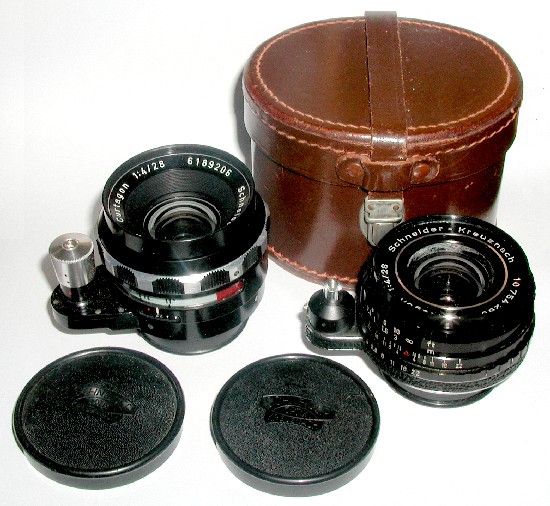 |
|
35mm f2.8 Auto Curtagon The 35mm Auto Curtagon, like the 28mm, above was furnished in two normal versions for the Exakta, as pictured on the left. It consisted of 6 elements in 6 groups and had f-stops from f2.8 to f22. Like the 28mm, it was also offered in the Lightmeter lens (LM) configuration and in Exakta REAL/Twin TL mounts. |
|
|
50mm f1.9 Auto Xenon The 50mm f1.9 Auto Xenon is one of the most popular normal lenses for the Exakta. In automatic mount, at least four versions exist as pictured to the right. As with the 28 and 35mm lenses above, the 50 f1.9 Auto Xenon was also available in the Lightmeter (LM) lens configuration and in Exakta REAL/Twin TL mounts. Schneider also manufactured a slower 50mm f2.8 Auto Xenar (not pictured) in both Exakta and Exakta REAL mounts. |
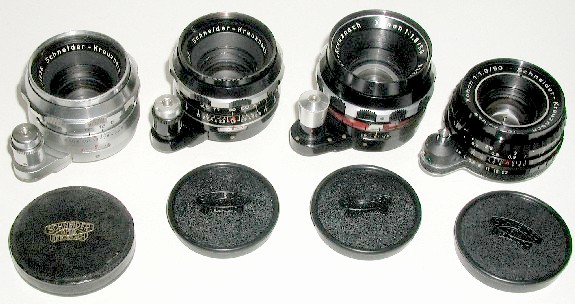 |
|
135 f3.5 Auto Tele-Xenar Next to the Carl Zeiss Jena 135mm Auto Sonnar, the Schneider 135mm Auto Tele-Xenars are most often encountered. The automatic Tele-Xenars were produced in three different basic black finish versions. In addition, as noted below, the lens was also offered in a lightmeter LM model and in Exakta Real/Twin TL mount as well. The type 2 is shown at the left; the type 3 is on the right. Each is displayed with its proper reversible hood, plastic cap and exquisite leather case. |
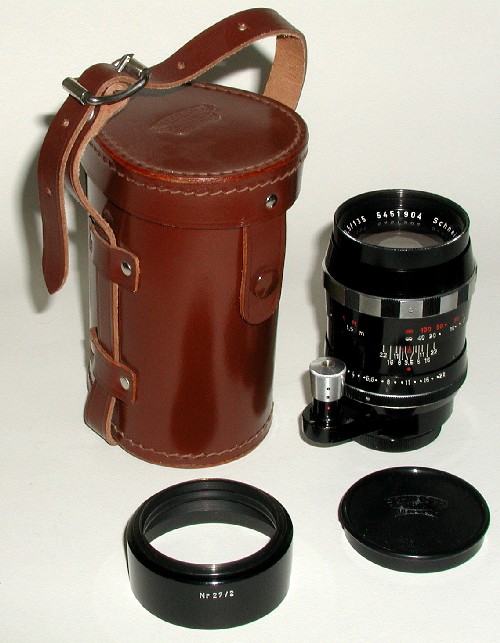 |
|
The Schneider Light Meter Lenses
In the early 1960's Schneider introduced an innovative line of lenses that permitted the attachment of cross-coupled selenium cell exposure meters. Advertising and written documentation from Schneider and Ihagee indicates that three focal lengths of the Schneider light meter lenses were produced:
|
35mm f2.8 Auto Curtagon (LM) 50mm f1.9 Auto Xenon (LM) 135mm f3.5 Auto Tele-Xenar (LM) |
|
|
|
The photo on the right shows the special locking flange used to hold the LM meter in place on the lens. |
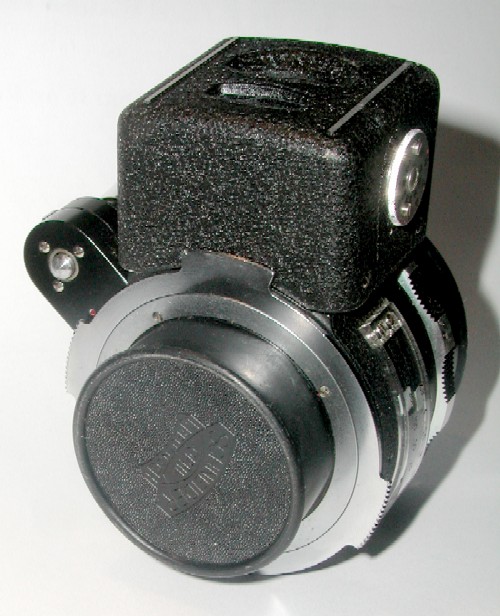 |
|
28mm f4.0 Auto Curtagon (LM) What most people don't know is that Schneider also produced in very small quantities, a 28mm f4.0 light meter lens in Exakta mount. The 28mm Auto Curtagon LM lenses were never discussed in any Schneider literature and are most uncommon. Pictured on the right, this rare lens is shown with its original Schneider box and lightmeter mount cap. |
 |
|
| I have been lucky enough to not only find one in Exakta mount in its original box, but one in M42 screwmount, as well, that I can use on my Exa Ib's and Ic's. | 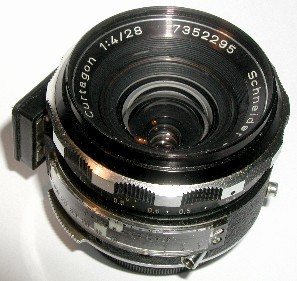 |
The Exakta Auto Variogon Zooms
Two Zoom lenses were produced in Exakta mount, an 80-240mm f4.0 Auto Variogon (1963) and a 45-100mm f2.8 Auto Variogon with an ingenious automatic diaphragm actuated via a release in the lens tripod socket that was designed to be used with a special pistol grip. Both lenses are uncommon.
| Schneider 40-100mm f2.8 Auto Variogon, complete with caps and hood | 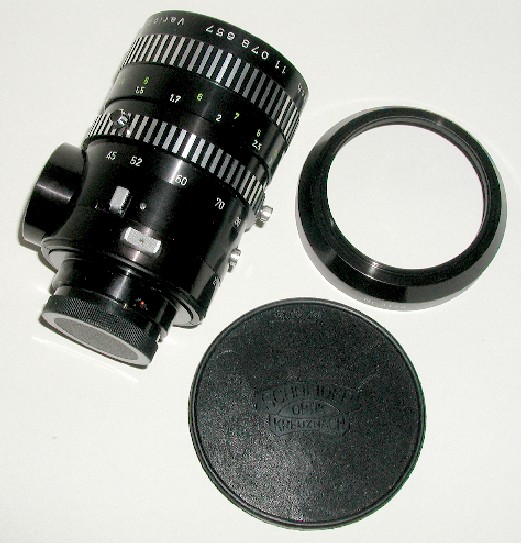 |
|
Schneider 80-240mm f4.0 Auto Tele-Variogon with Caps & Hood The 80-240mm Auto is a mate to the 40-100. It utilizes the same trigger pistol grip and cable to stop down the lens.This large Schneider Zoom is a rather complex formula. It consists of 6 elements in four groups in the fixed lens section and 8 elements in five groups in the variable section. Focusing is effected via adjustment of the 3 front elements of the variable section. F-stops range from f4 to f22 and the lens focuses as close as 6 feet. 82mm filters can be fitted to the front lens threads. |
 |
| A very special unique pistol grip was manufactured by Schneider for the Auto Variogon Zoom lenses to activate their semi-automatic diaphragms. They are quite uncommon!!! | 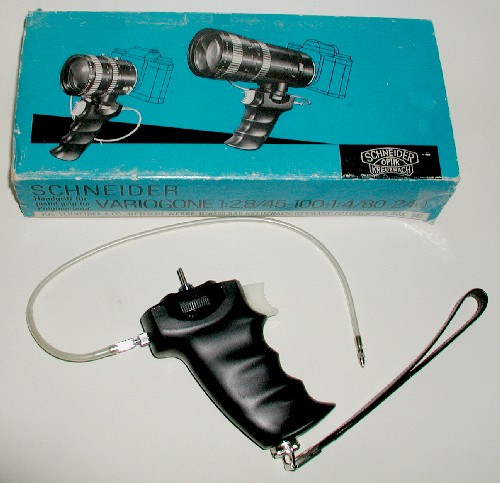 |
| Here is a photo of the complete setup, an Exakta VXIIa with the 45-100mm Variogon mounted with the pistol grip, cable release and strap. A quite comfortable outfit!!! |  |
The Exakta 80-240mm preset Variogon
|
Schneider 80-240mm f4.0 Variogon (Preset) with Caps, Hood and Fitted Leather Case The preset version 80-240mm Variogon is similar to the automatic version however, it lacks the strap lugs and has a different style tripod mount. |
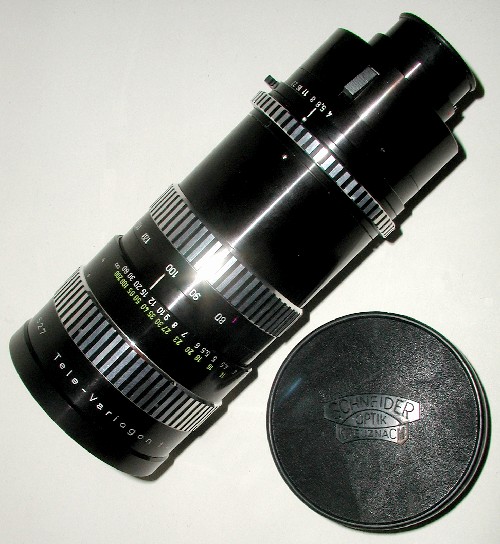 |
Interesting Schneider Presets
To accompany my collection of automatic Exakta lenses, I have added the following lenses to my collection:
|
90mm f3.5 Tele-Xenar (preset) 135mm f4.5 Xenar [Bellows Lens] with focusing mount 35mm f4.0 Curtagon (preset) 35mm f4.0 Radiogon (preset) The 90mm Tele-Xenar is an excellent portrait lens. It is unfortunate that Schneider never offered it in fully automatic mount. It is also interesting to note that the 35/4 Curtagon and the 35/4 Radiogon appear to be identical in every respect with the Radionar having an earlier serial number. |
|
|
|
135mm f3.5 Tele-Xenar (preset) The late-model 135mm f3.5 Tele-Xenar with preset diaphragm is one of the rarer Schneider lenses in Exakta mount. I've personally seen hundreds of the automatic 135's but this is only the third late model preset one I've ever seen. In this preset configuration, the lens has f stops from f3.5 to 22 and focuses as close as 1.5 meters.
|
 |
|
200mm f5.5 Tele-Xenar (preset) 360mm f5.5 Tele-Xenar (preset) For many years the 360 Tele-Xenar was my favorite lens for wildlife photography. It's a very sharp optic and a pleasure to use particularly when fitted with a shoulder stock. Both the 200 and 360 Tele-Xenars stop down to f32 and have reversable lens hoods. |
|
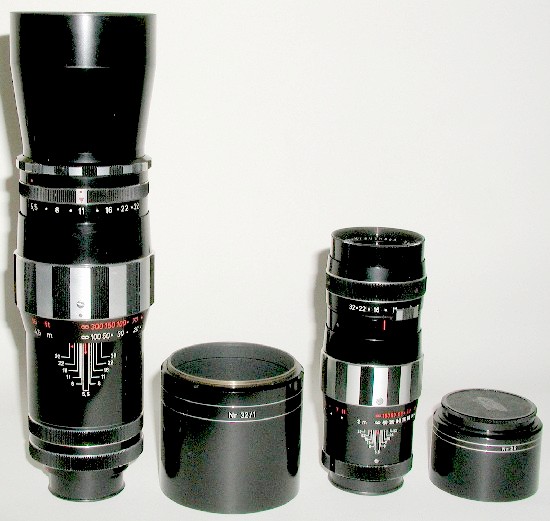 |
The Schneider PA- Curtagon
|
One of the most interesting optics that Schneider produced in Exakta mount (as well as in other mounts) was the 35mm f4.0 PA-Curtagon. The PA-Curtagon was engineered primarily for architecture photography. It enabled the shifting of the entire optics off-axis so as to correct perspective distortion. Everyone has seen photographs of churches, skyscrapers, etc. that seem to be falling over backwards. The PA-Curtagon was designed to correct that. The lens has a manual diaphragm and focuses from infinity down to about 10 inches. Its formula consists of 7 elements in 6 groups and has f-stops from f4 to f22. They are most uncommon. |
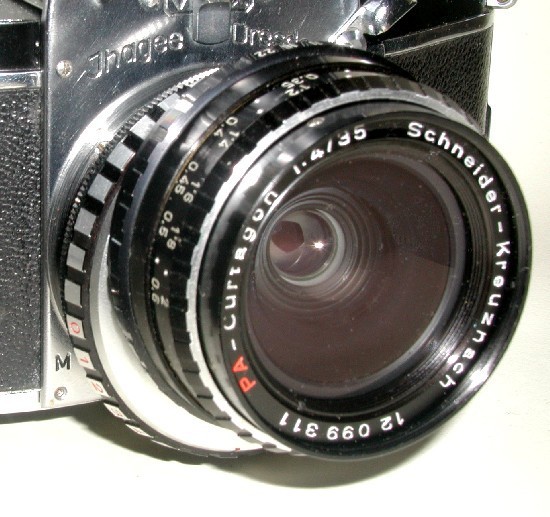 |
Early Schneider Wide-Angle
|
40mm f4.5 Jsogon The 40mm Schneider Jsogon (pronounced Eye-So-Gone) was the second earliest wide-angle lens manufactured for the Kine-Exakta. (The 40mm Carl Zeiss Jena Tessar being the first.) Introduced in 1951, it had a fully manual diaphragm with f/stops down to f22 and focused as close as 1.75 feet (0.5m). A word of caution if you own one of these lenses. The rear element is paralell to the rear of the lens. If you place the lens down without a rear lens cap, the rear lens element can come in contact with the surface on which you place it. |
|
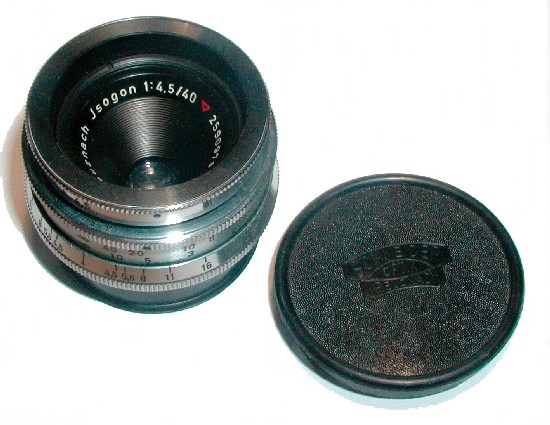 |
Magnificent Early Tele-Xenar
|
300mm f5.5 Tele-Xenar (manual) The 300mm f5.5 Tele-Xenar displayed on the left is seldom encountered in such clean condition. The black enamel barrel is easily scuffed. The lens has f-stops from f/5.5 down to f/32 and focuses as close as 5 meters. It is displayed with its' proper front and rear caps. |
|
|
Schneider Lenses for the Exakta REAL/TWIN TL
Schneider produced a number of lenses with a special bayonet mount for the Exakta REAL and Twin TL Cameras. The lenses offered included a 28mm f4.0 Auto Curtagon, a 35mm f2.8 Auto Curtagon, a 50mm f2.8 Auto Xenar, a 50mm f1.9 Auto Xenar and a 135mm f3.5 Auto Tele-Xenar. The 80-240mm f.4.0 Variogon was also offered, although there is some question if it was ever produced. In looking at some Exakta Real literature, it appears as if the Variogon shown has an Exakta Varex to Exakta Real adapter on it and it is likely that it was disrtibuted that way.
|
In the accompanying photo on the right, I have displayed the 35, 50 f2.8, 50 f1.9 and the 135 mm Schneider lenses in Exakta Real mount, each with their proper caps and original blue Schneider boxes. A. Schacht-Ulm was the only other German lens maker who produced lenses for the Real. Steinheil was beginning to tool up to produce Real lenses when the production of the short-lived Exakta Real ceased. In the photo below,
the 28/4 Curtagon in Real mount is displayed. |
|
|
Schneider Lens Brochures
| The photo on the right shows three different Schneider 35mm Lens Brochures - 1957, 1959 and 1970. The 1970 version shows the later Schneider auto optics as well as the rare PA-Curtagon shift lens. |  |
| The photo on the near right shows the Schneider brochures covering the semi-automatic Tele-Variogon Zoom Lenses. The brochure on the far right shows the brochure for the preset version. |  |
Today, Schneider is still one of the world's premier optical manufacturers producing lenses for every format. They have a proud heritage, indeed!!!
© The material on this web site is copyrighted and the property of Captain Jack. With permission you may hyperlink to my items.
